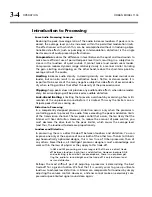
OPTIMOD-PC
OPERATION
3-17
Two-Band:
The Two-Band structure consists of a slow two-band gated AGC (Auto-
matic Gain Control) for gain riding, followed by a gated two-band compressor and a
look-ahead limiter. By choosing the AGC crossover mode correctly, the Two-Band
Structure can be made phase-linear throughout to maximize sonic transparency.
The Two-Band structure has an open, easy-to-listen-to sound that is similar to the
source material if the source material is of good quality. However, if the spectral
balance between the bass and high frequency energy of the program material is
incorrect, the Two-Band structure (when its
B2-B1
C
OUPLE
control is operated to-
ward 0%) can gently correct it without introducing obvious coloration.
In radio-oriented applications, the Two-Band structure is mainly useful for classical
or “fine arts” programming that demands high fidelity to the original program
source. The
PROTECTION
preset is a Two-Band preset that provides the highest fi-
delity; other Two-Band presets provide more processing.
The Two-Band structure preserves the frequency balance between midrange and
high frequency elements in the programming while permitting gentle automatic re-
equalization of the balance between these elements (in the “Master” band, which is
above 200 Hz) and elements in the “Bass” band (below 200 Hz).
The AGC and two-band crossovers can be configured to be either phase-linear (i.e.,
constant-delay) or “allpass.” “Allpass” provides minimum time delay along with a
frequency response that is free from peaking or dipping when band gains are un-
equal. “Allpass” also helps make speech waveforms more symmetrical. The delay-
line derived phase-linear crossover has the same desirable smoothness in its fre-
quency response as “allpass,” while adding 4 ms of delay to the processing. Most
two-band presets use the delay-line derived phase-linear crossover configuration.
Factory Programming Presets
Factory Programming Presets are our “factory recommended settings” for various
program formats or types. The Factory Programming Presets are starting points to
help you get on the air quickly without having to understand anything about ad-
justing OPTIMOD-PC’s sound.
You can easily edit any of these presets with the
L
ESS
-M
ORE
control to optimize the
trade-off between loudness and distortion according to the needs of your format,
although this is often unnecessary. It is OK to use unmodified factory presets on the
air. These represent the best efforts of some very experienced transmission process-
ing sound designers. We are sometimes asked about unpublished “programming
secrets” for Optimods. In fact, there are no “secrets” that we withhold from users.
This manual reveals our “secrets” and the presets embody all of our craft as process-
ing experts. The presets are editable because other sound designers may have dif-
ferent preferences from ours, not because the presets are somehow mediocre or im-
provable by those with special, arcane knowledge that we withhold from most of
our customers.
Start with one of these presets. Spend some time listening critically to your sound.
Listen to a wide range of program material typical of your format and listen on sev-
eral types of audio systems (not just on your studio monitors). Then, if you wish, cus-
















































